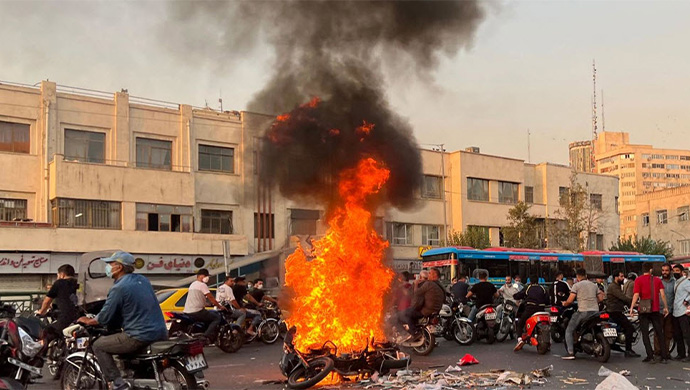Iran’s latest nationwide uprising has now been going on for five weeks. During that time, it has grown to encompass nearly 200 different cities while acquiring involvement from a wide range of age groups, professions, ethnic and religious demographics. High school girls have become a major driving force in calls for societal revolution and regime change. But young Iranians have recently received vital support from veteran oil workers, whose resulting strikes have drawn notable comparisons to the conditions preceding the overthrow of the Shah regime in 1979.
Despite this, there appears to still be a preponderance of doubt in Western media and Western policy circles regarding the prospects of a new revolution emerging from the current unrest. Such doubt is clearly misplaced in light of the sheer volume and diverse backgrounds of Iranians who are presently chanting slogans like “death to the dictator” and “down with tyranny, both the mullahs’ and the shah’s” while using rocks and bare fists to fight back against heavily-armed security forces. But that doubt has always been replaced, and has always stemmed from faulty assumptions about the domestic power and political stability of the mullahs’ regime.
The current uprising is less indicative of the end of that stability than it is a reminder that the regime’s hold on power was not particularly secure to begin with. Although numerous media commentators have rightly observed that this uprising is substantially different from its predecessors, it is nonetheless the culmination of an anti-government protest movement that has been growing and developing at least since the end of 2017.
That was when chants of “death to the dictator” truly entered the mainstream, in reference to the regime’s Supreme Leader Ali Khamenei. And by mid-January 2018, those chants could be heard in well over 100 cities and towns across Iran. This prompted Khamenei himself to deliver a speech in which he sought to explain away the apparently very widespread calls for regime change. But in attempting to do so, the regime’s top cleric only succeeded in undermining his own propaganda by acknowledging that the leading pro-democracy opposition group, the People’s Mojahedin Organization of Iran (PMOI/MEK), had “planned for months” to organize and lead the unrest.
The MEK’s role has been evident in each of nine successive uprisings, thanks in large part to the proliferation of “Resistance Units,” a network of dissident activists organized throughout the country for the express purpose of promoting overthrow of the ruling system. The growth of that network over just the past year has been truly impressive. In advance of an international summit organized by the National Council of Resistance of Iran in 2021, around 1,000 Iranian citizens sent anonymous video messages expressing their commitment to the mission of the Resistance Units. At a similar event in the summer of this year, the number of submissions grew fivefold.
Furthermore, throughout the network’s five years of operation, the tactics and social reach of Resistance Units have grown dramatically. In January of this year, they set fire to a newly unveiled statue of Qassem Soleimani, the commander of the Islamic Revolutionary Guard Corps’ Quds Force who was killed in a US drone strike two years earlier. This marked an escalation to a longstanding strategy of burning symbols of the regime’s hold on power, and directly challenged propaganda which sought to portray Soleimani as a hero.
In the wake of that incident, activists took control of a state media broadcast and brought down government websites, using both to present the images and voices of Iranian Resistance leader Massoud Rajavi and President-elect of the NCRI Mrs. Maryam Rajavi. The state media control was repeated in context of the present uprising, thereby serving as a reminder that there is organized leadership behind the movement for regime change, and thus also behind the uprising at hand.
That leadership has been instrumental in helping protesters to overcome the regime’s restrictions on internet access and on the flow of information both into and out of Iran. It has also surely inspired Iranians to go on standing up to repressive authorities, even after they killed more than 400 people in connection with the uprising. Furthermore, that leadership serves to remind the international community that the mullahs’ ouster will lead to defined outcomes, namely implementation of Maryam Rajavi’s 10-point plan to establish a free, democratic Iranian republic.
Tehran killed dozens of activists and imprisoned thousands
Tehran has made every effort to suppress public support of that plan and that alternative leadership. It killed dozens of activists and imprisoned thousands in the wake of Khamenei’s acknowledgement of MEK activity in 2018. And later in that year, on orders from regime authorities, an Iranian diplomat named Assadollah Assadi attempted to carry out a terrorist attack on an NCRI gathering near Paris, with the primary goal of targeting Mrs. Rajavi. When that plot failed and protests re-emerged on an even grander scale the following year, the IRGC opened fire on crowds of protesters and within days killed 1,500 participants in the November 2019 uprising.
Yet protests resumed in more than a dozen provinces just two months later. And when it became clear that the existing security apparatus was failing to contain anti-government sentiment, the regime began reorganizing all of its suppressive forces, including State Security Forces, the IRGC, the Basij militia, and plainclothes agents. The current uprising is taking place in the wake of that reorganization, which has clearly failed in its task and will ultimately fail to prevent the Iranian people from removing the clerical dictatorship.
The international community must promptly recognize this fact, recognize its prior mistake of assuming that there was no viable alternative to the mullahs, and begin pursuing policies that reflect this new reality by supporting the Iranian people and their right for self-defense while isolating and exerting the utmost pressure on the outgoing regime.





